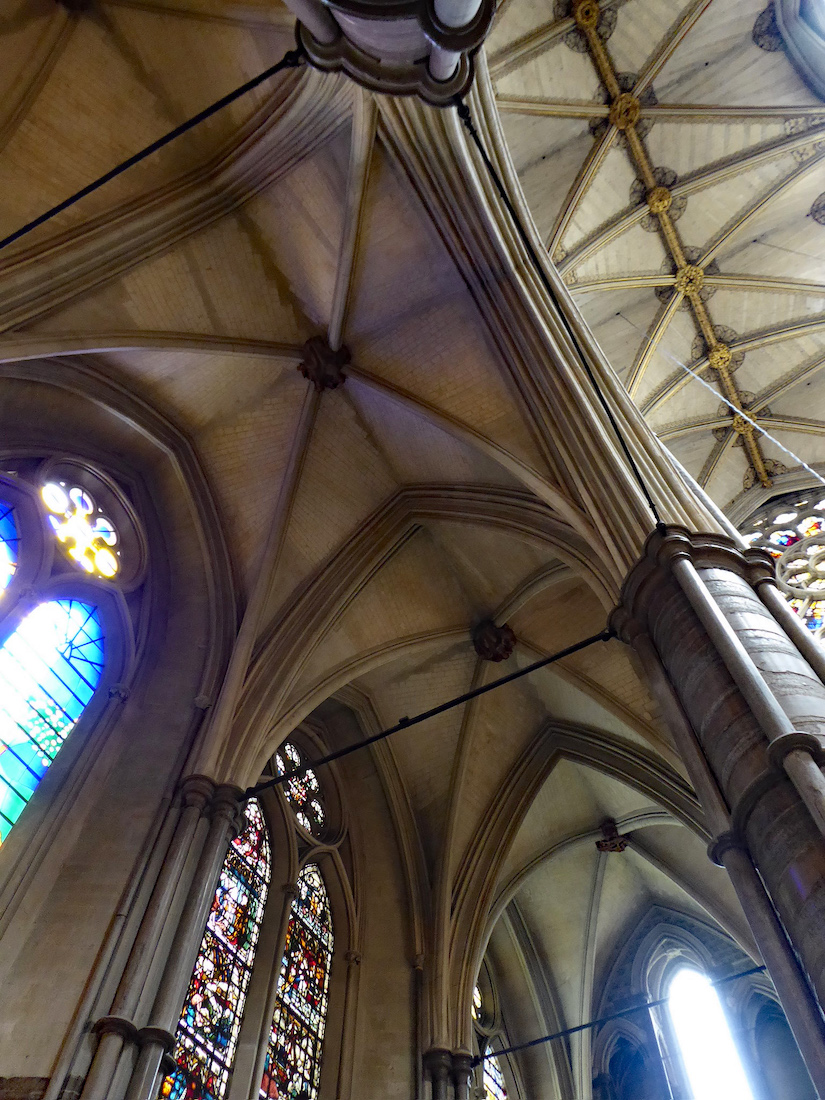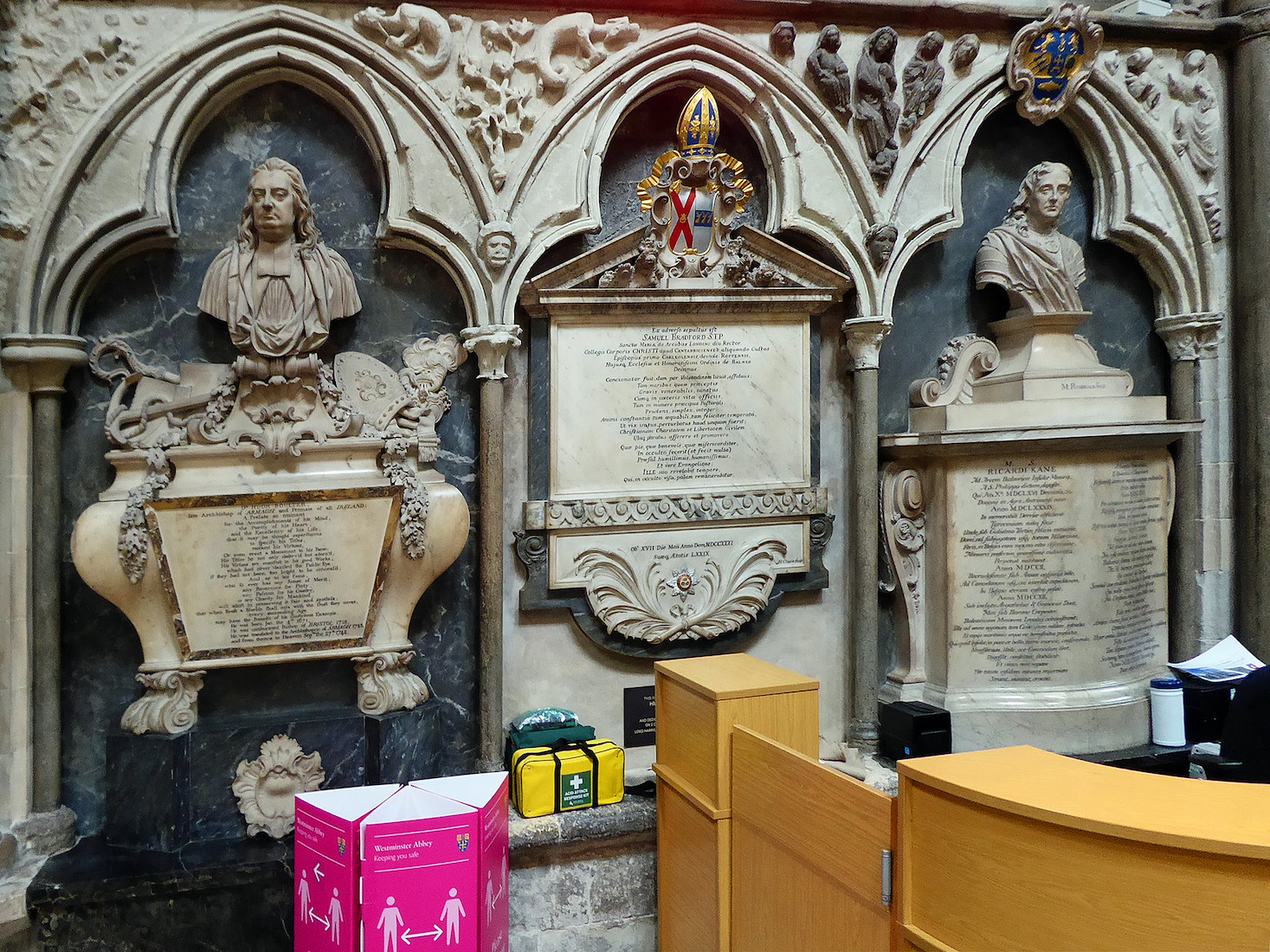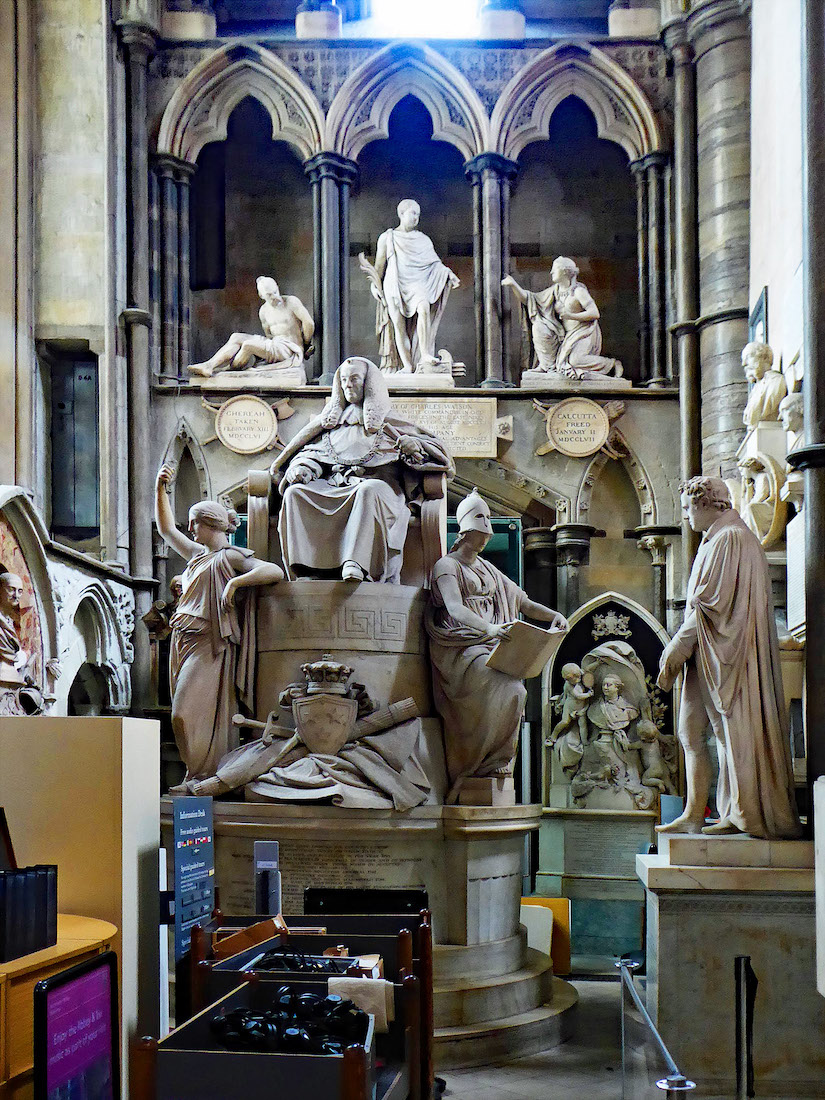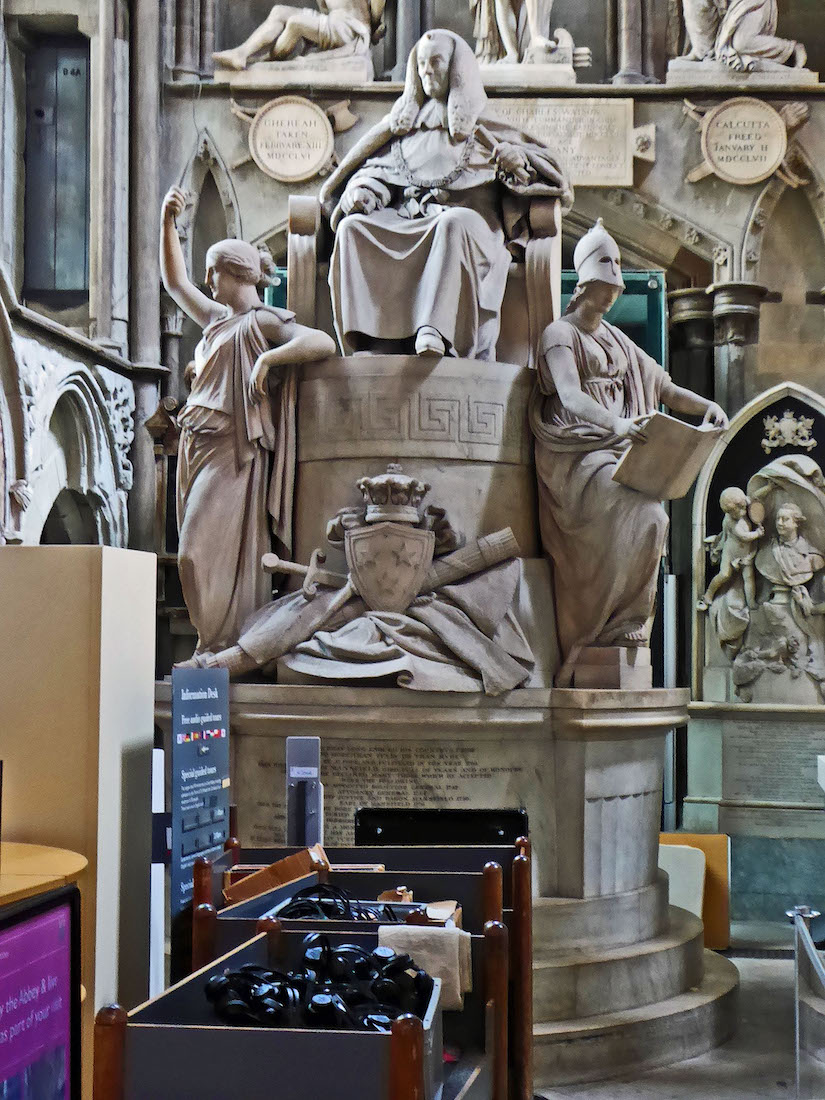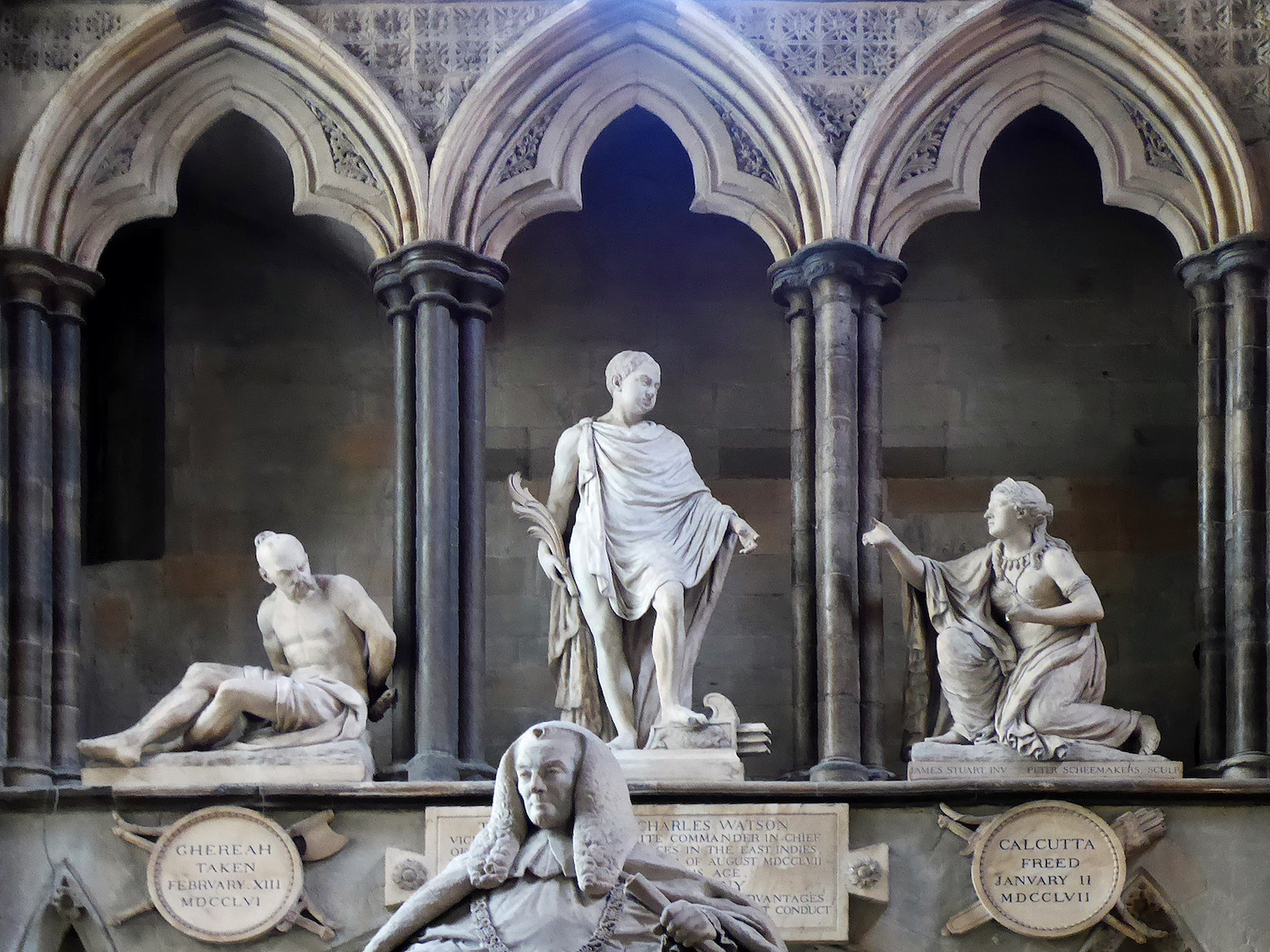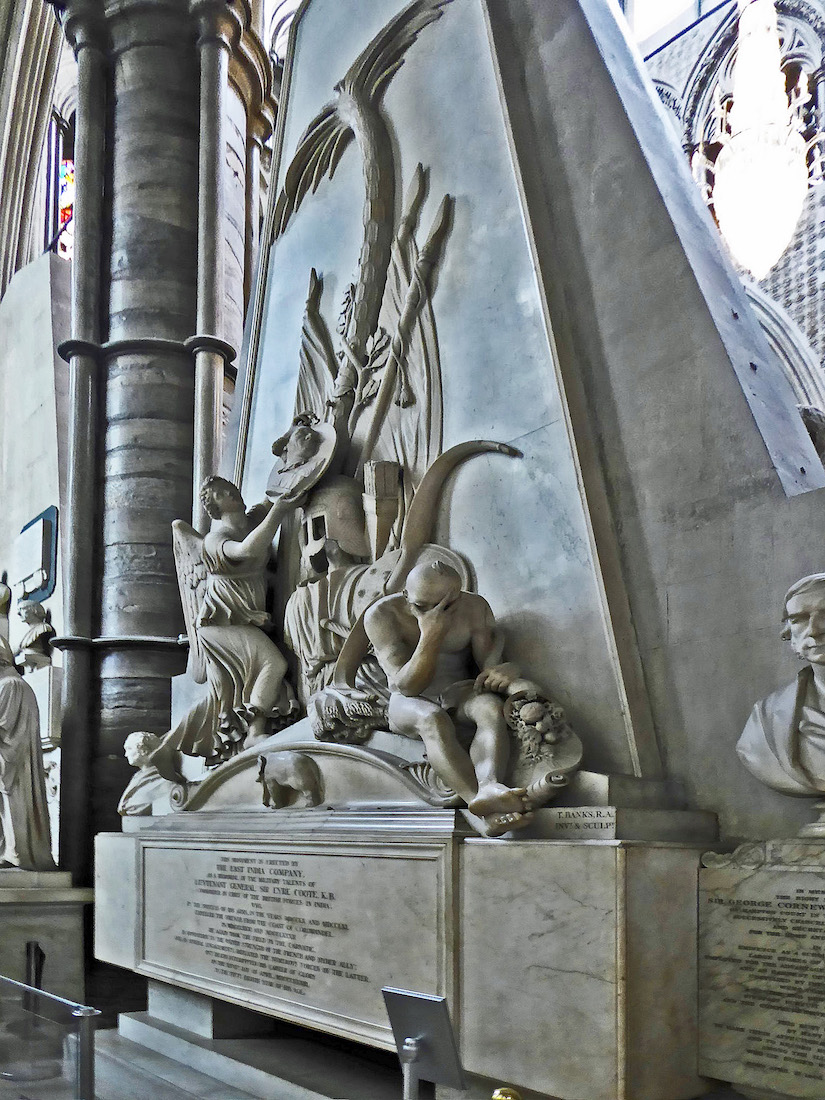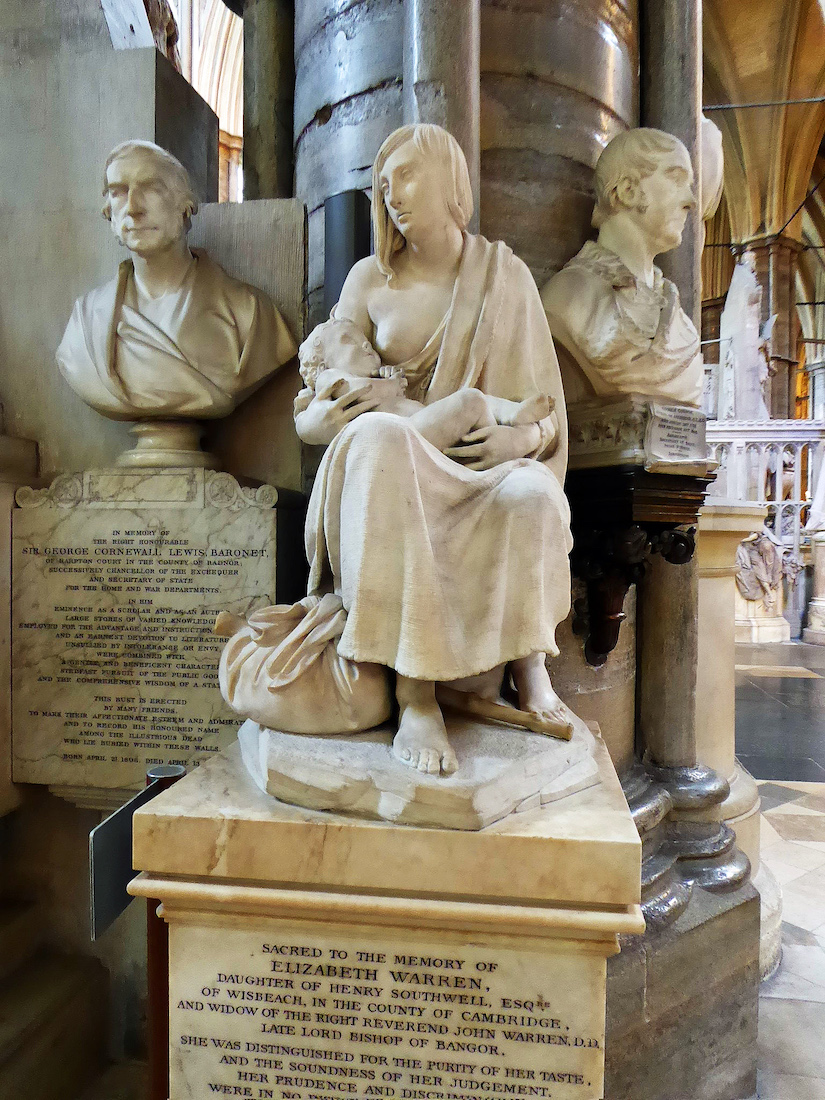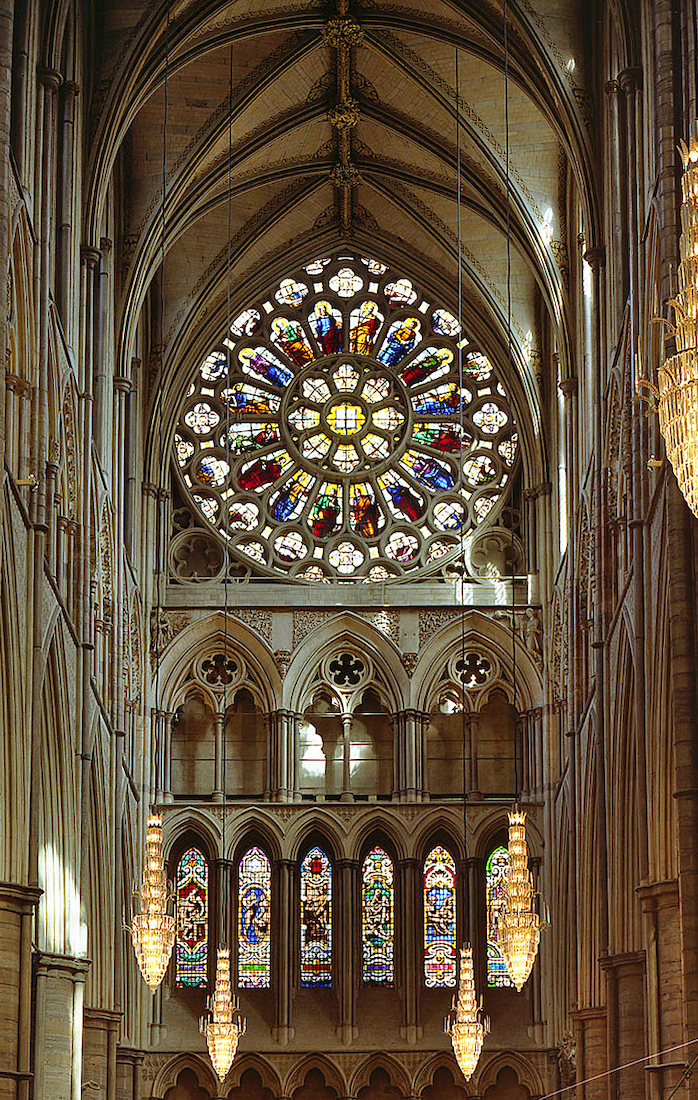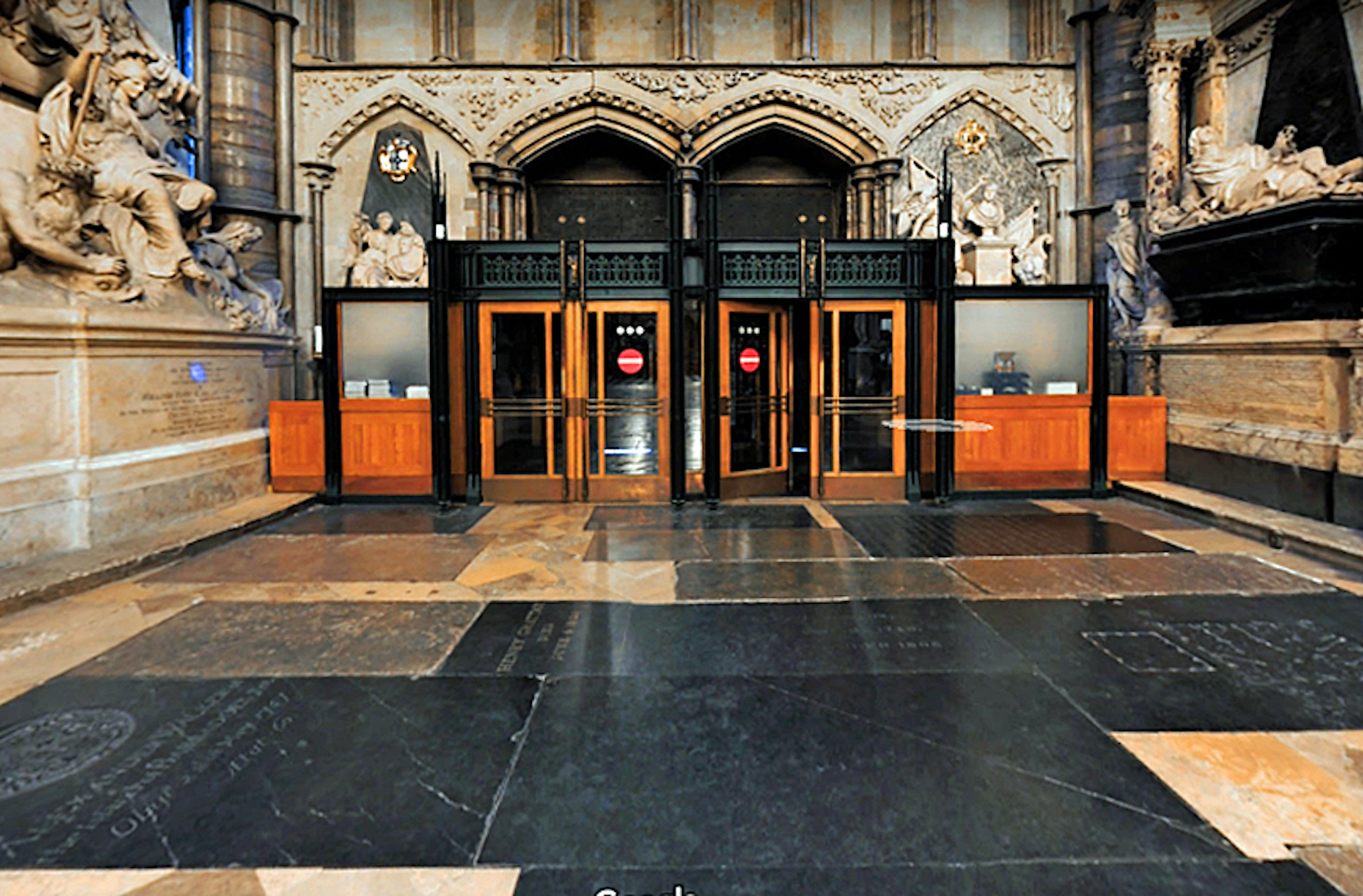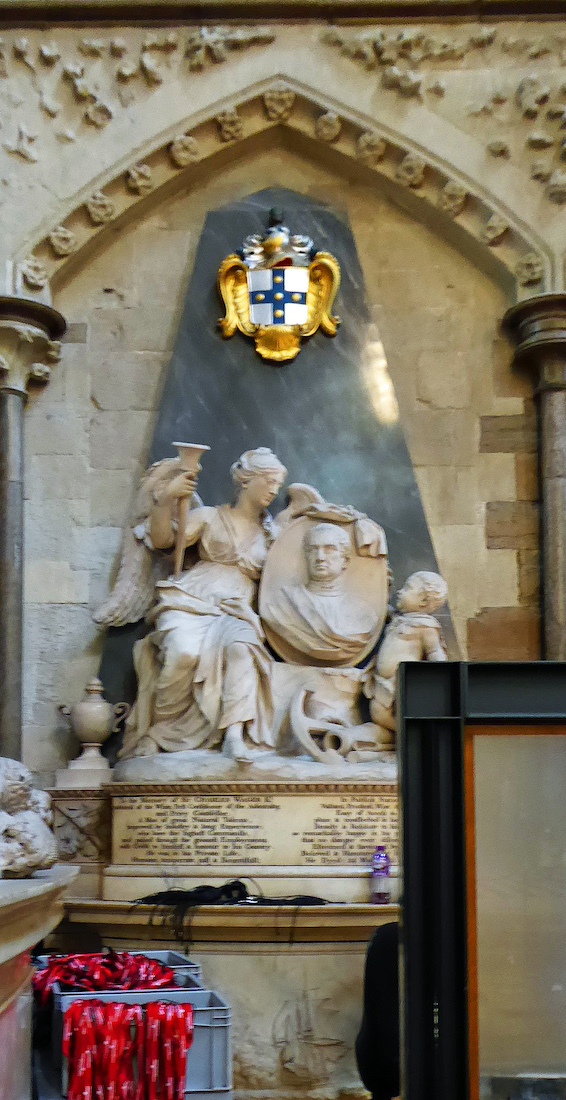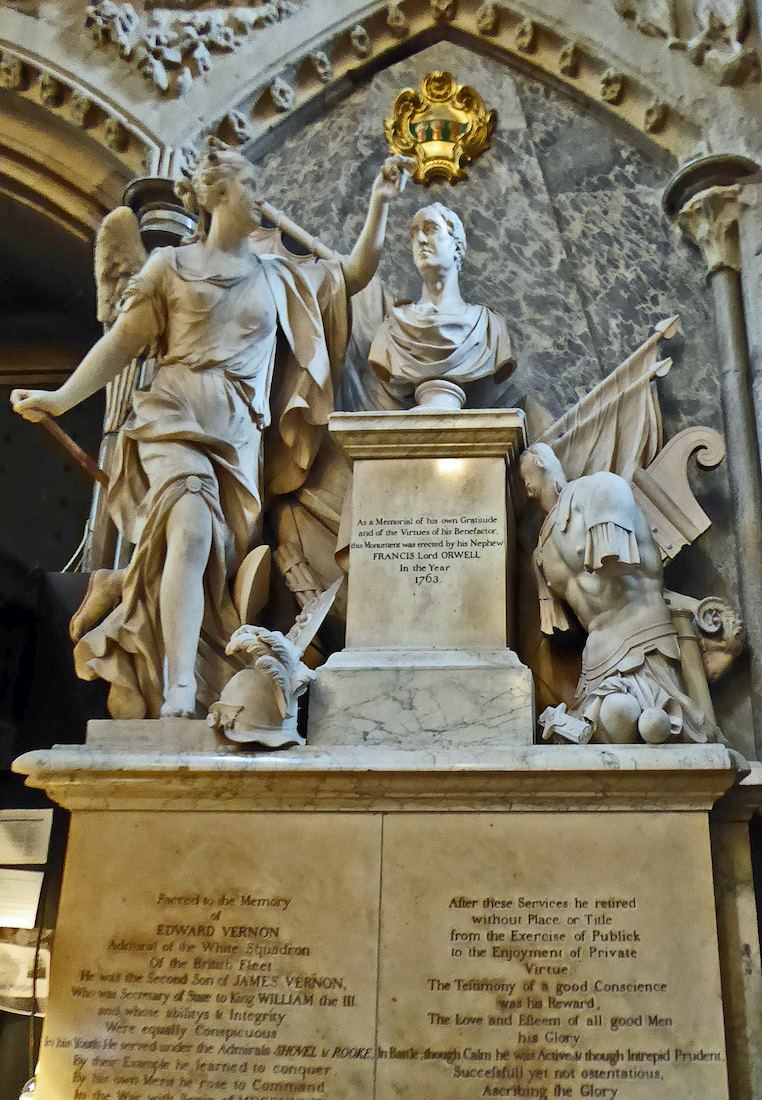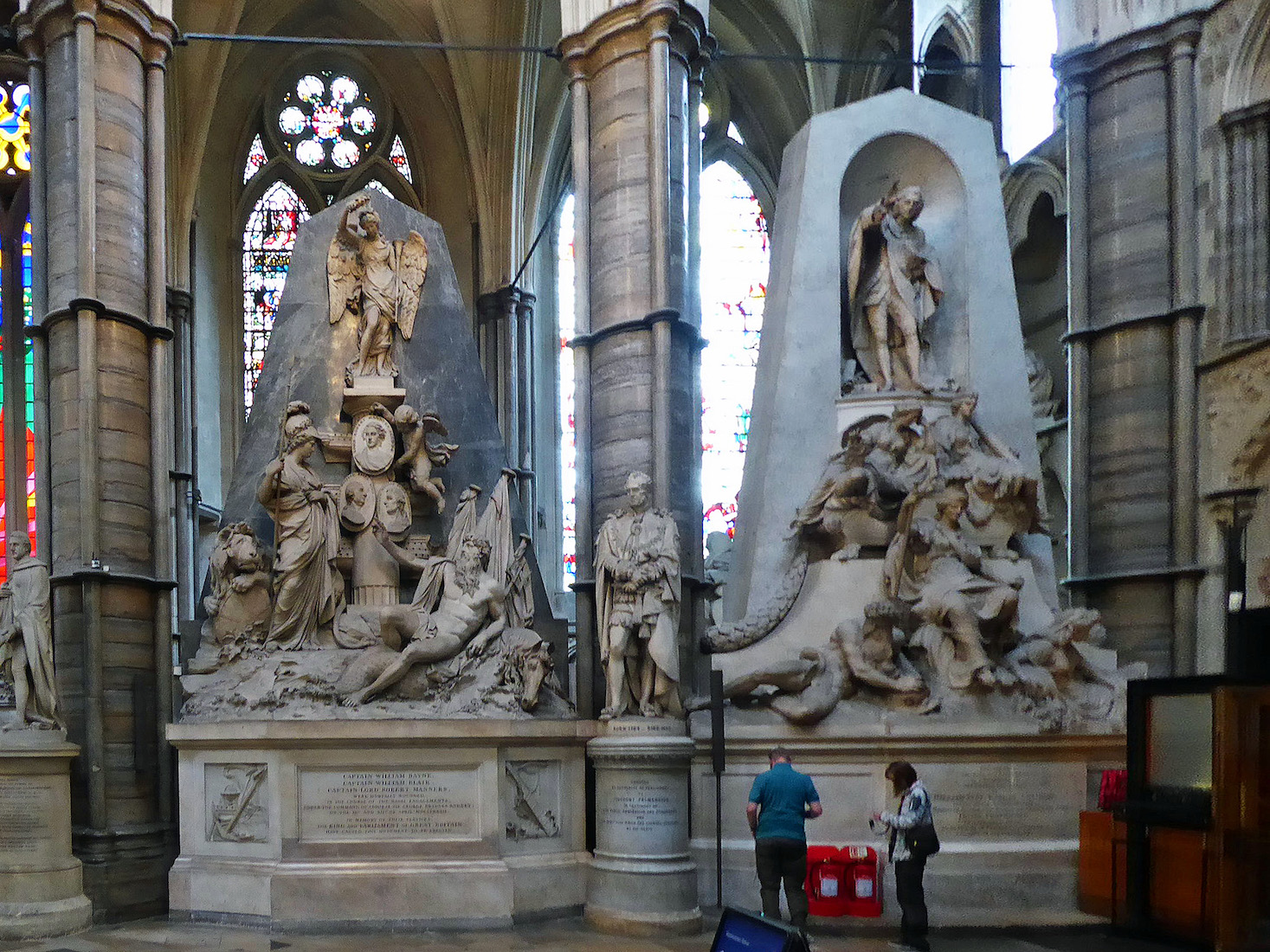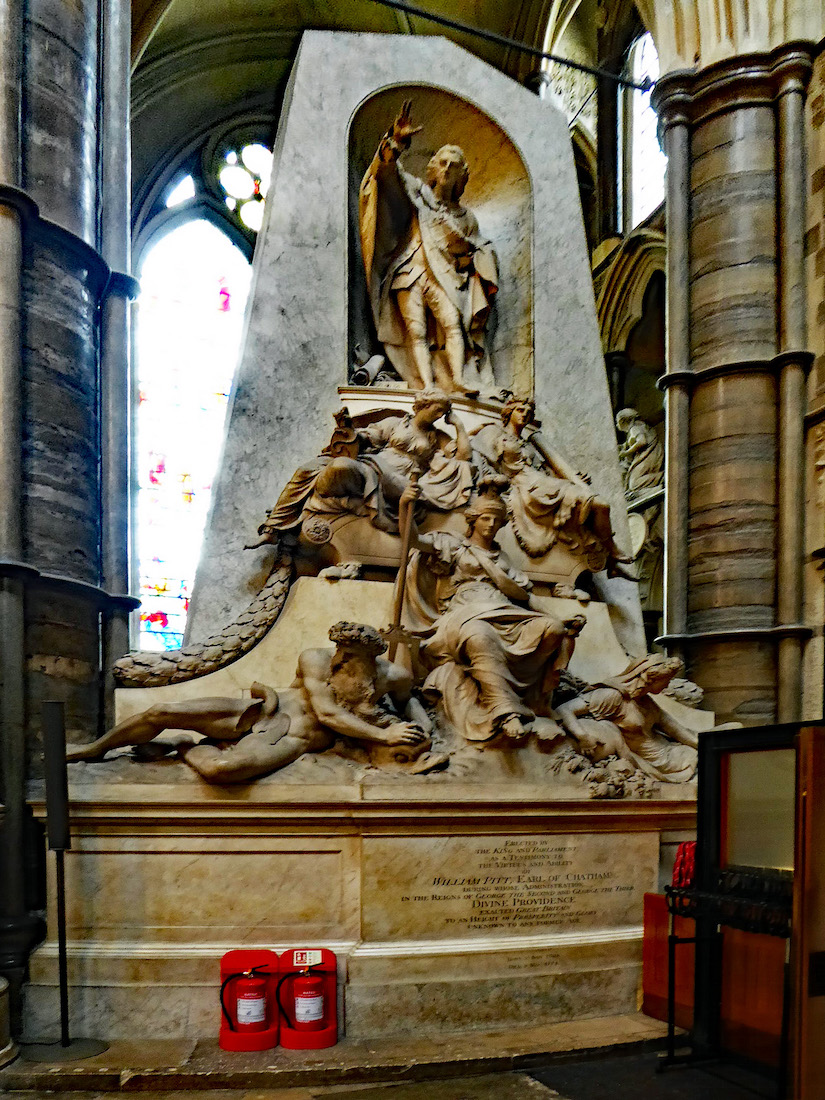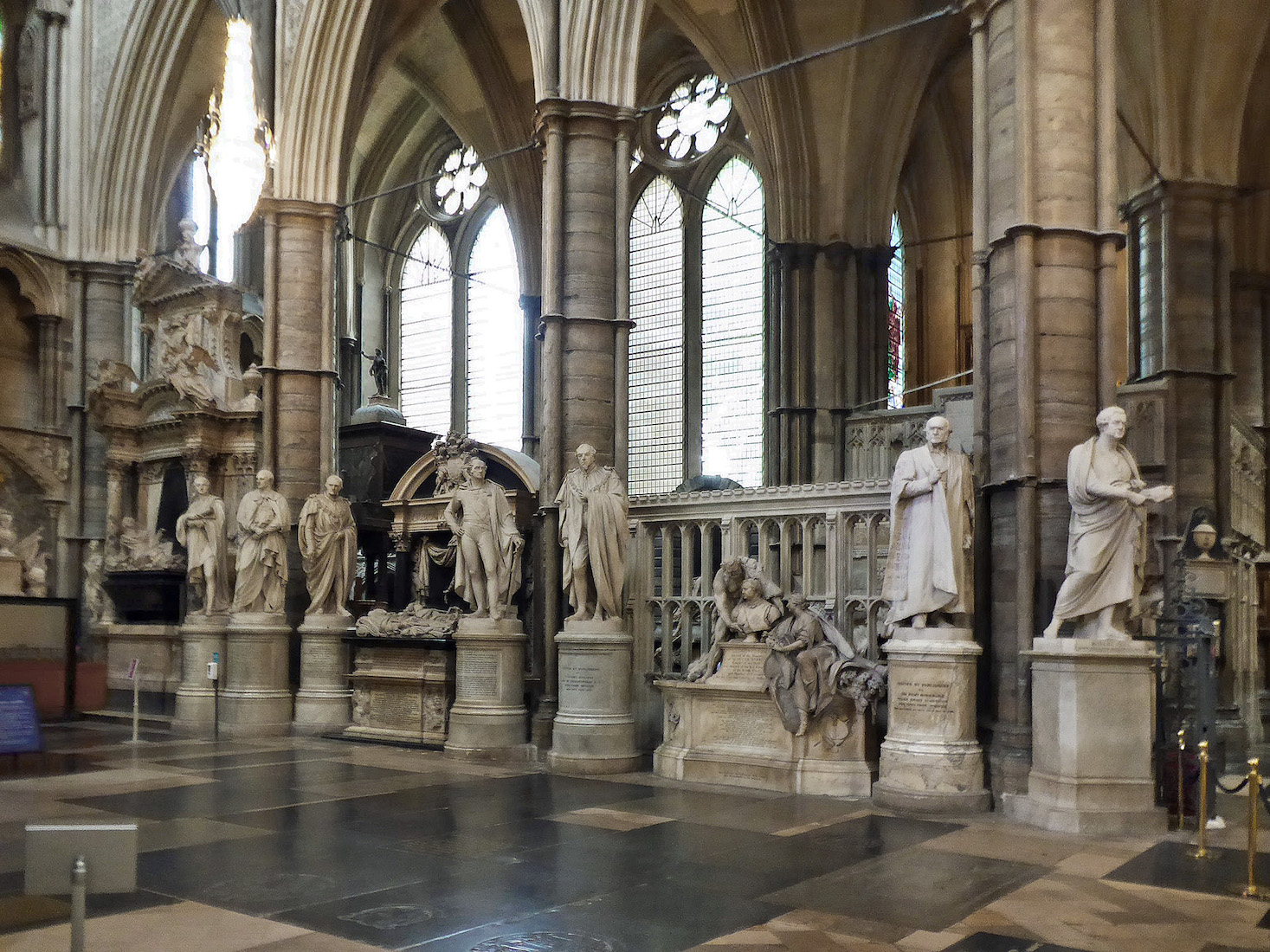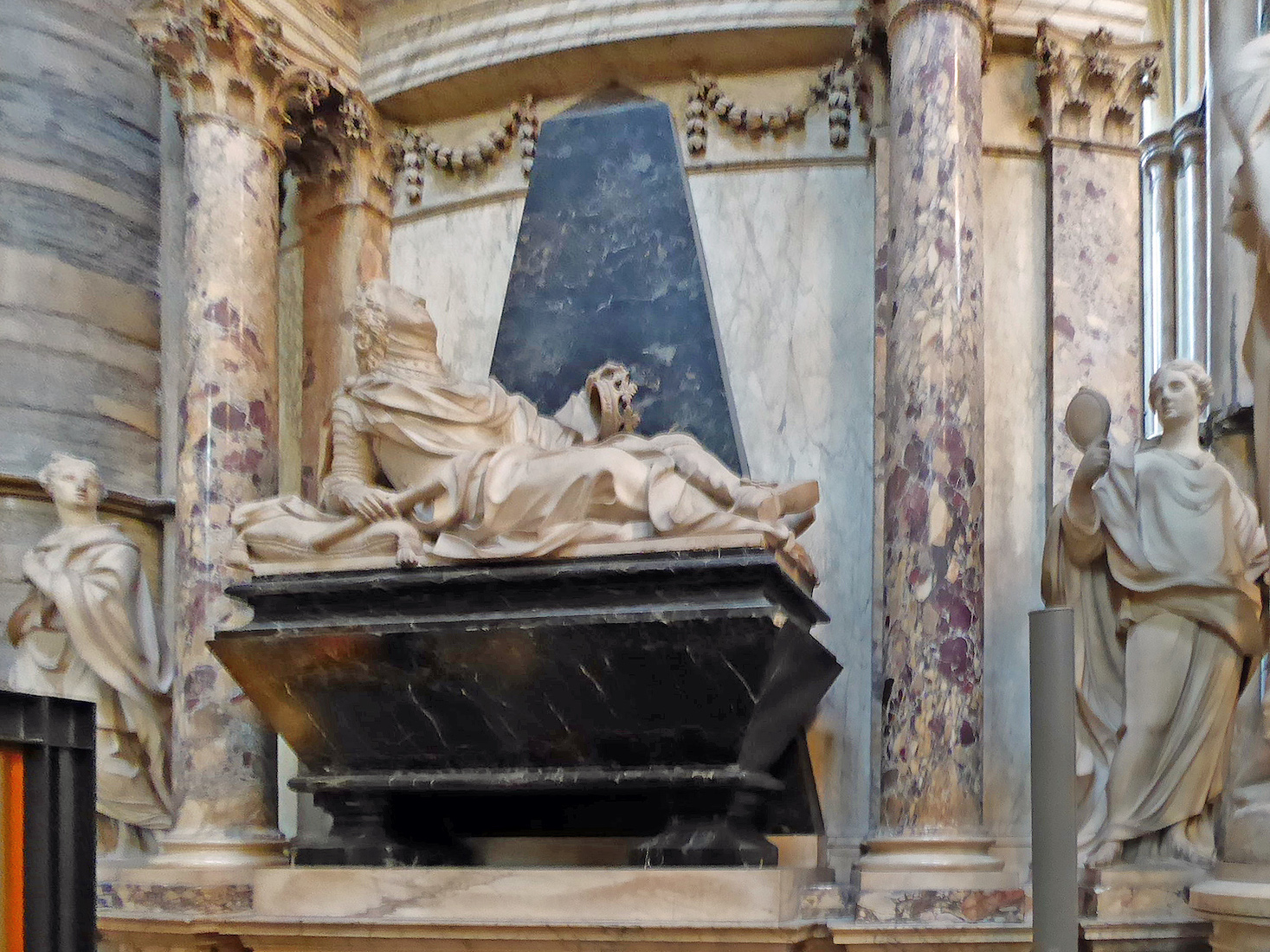D. NORTH TRANSEPT
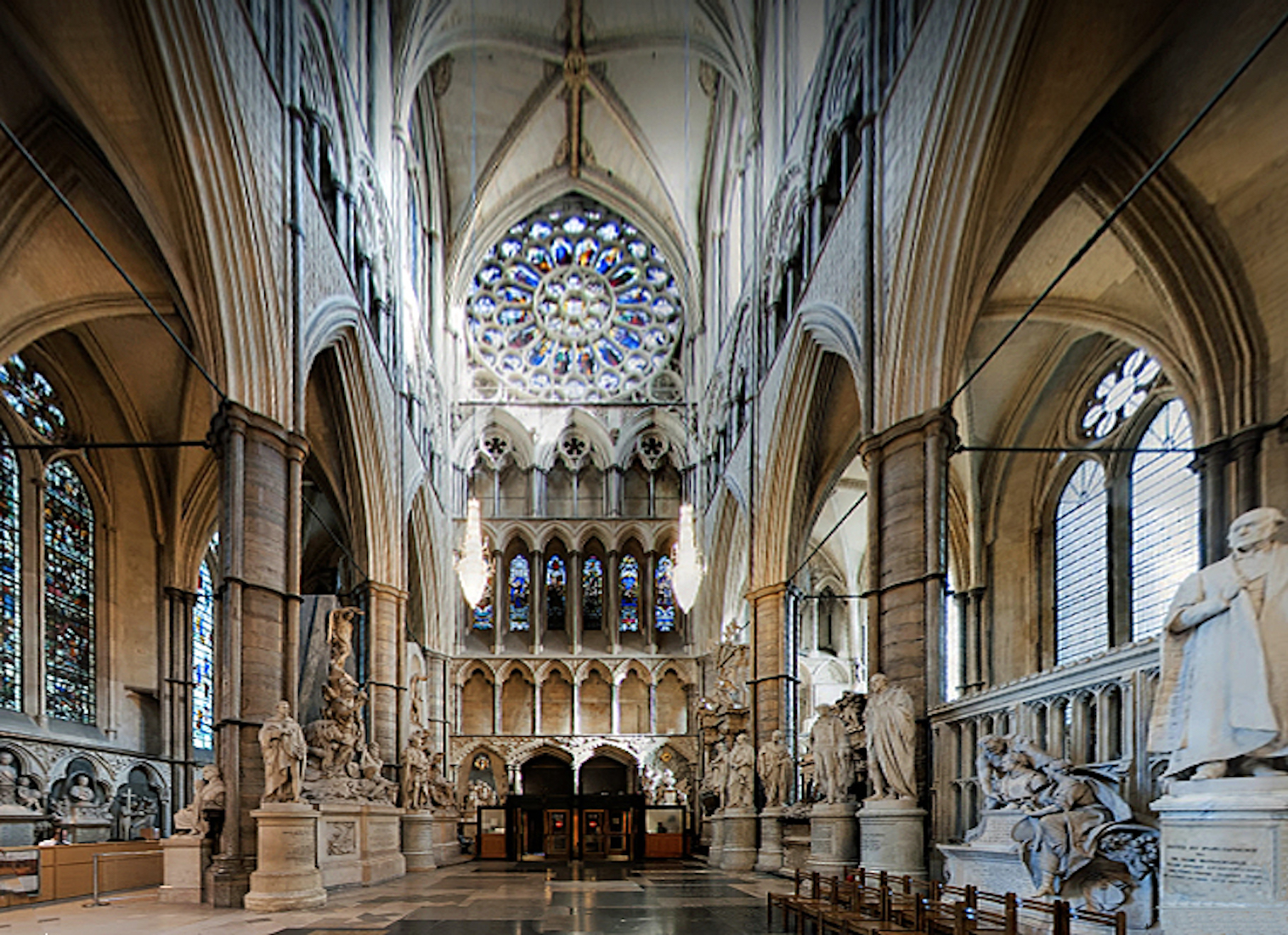
We now begin our investigation of the North transept. This transept has a wide central aisle, with a narrower aisle on either side. It also has three bays, and we continue the numbering we have followed in the nave and choir, naming these Bays 10, 11 and 12. The wall ahead of us features a large rose window with six stained glass lancet windows below. Below this is a wide modern door, allowing for the many visitors who come into the Abbey through this entrance. We notice too the Visitors’ Desk at extreme left, and the (in fact three) stained glass windows along this West wall. We see already that there are many monuments in this section of the Abbey, including the famous Line of Statesmen to the right of the central aisle. INDEX
D2. WEST AISLE BAY 10, AND HOCKNEY WINDOW AMT
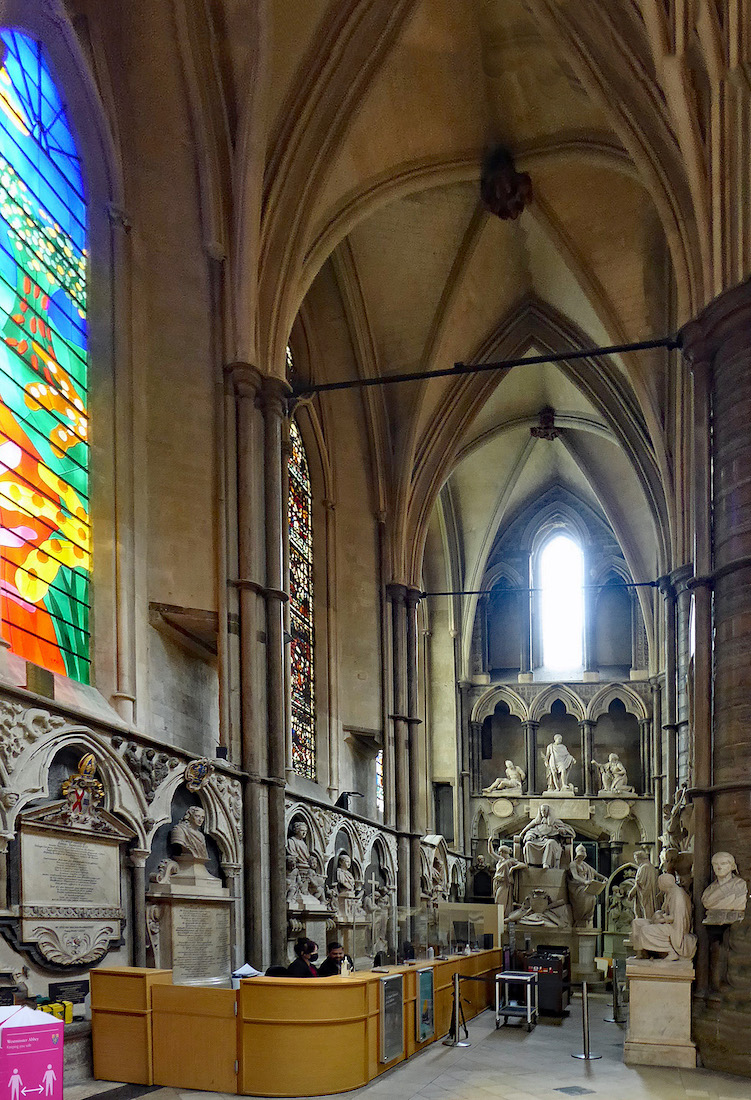
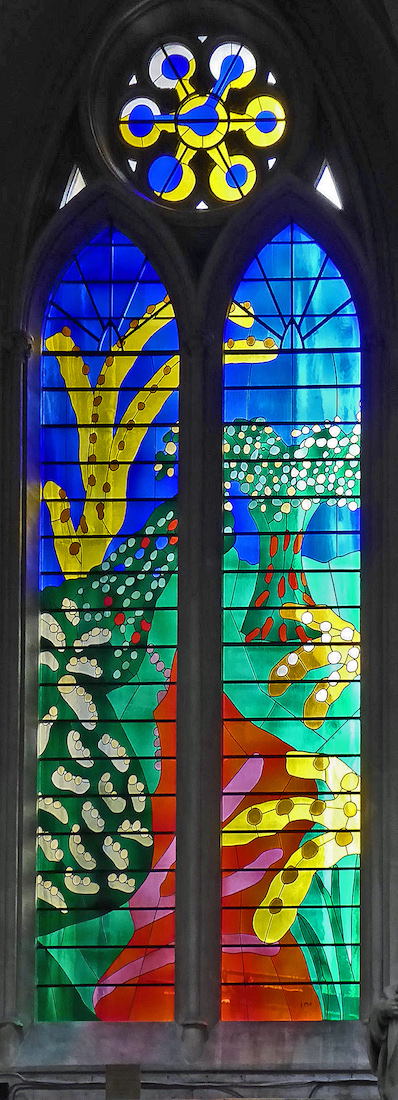
We turn our attention to the Western aisle, and the colourful Hockney window. The ‘Queen's window’ by David Hockney was installed in 2018 to celebrate the reign of Elizabeth II. It is said to depict a country scene featuring hawthorn blossom, and to reflect Elizabeth II’s interest and delight in the countryside. The design of the window and its placing in the Abbey received mixed reviews. On the positive side, it is very bright and colourful ... .
D3. GLIMPSE OF BAY 11 WINDOW AMT
As mentioned earlier, this West wall of the transept contains three stained glass windows. The central window depicts the miracles of Jesus, but unfortunately I have been unable to find photographs of these remaining two windows.
D4. WEST WALL BAY 10, MONUMENTS AMT
There are three monuments on the wall behind the Visitors’ Desk. From left these are: •• a memorial to Hugh Boulter, archbishop of Armagh. He was buried nearby in the transept in 1742. The memorial was designed by Sir Henry Cheere and includes a bust of the archbishop with decorations of a mitre, crozier, lamps, sprays of oak leaves and acorns; •• at centre, a monument remembering Bishop Samuel Bradford who was buried in the transept in 1731. He was Dean of Westminster and Bishop of Rochester. The monument shows his coat of arms above with the Star of the Order of the Bath between palm branches below; •• at right is a memorial to military commander Richard Kane. It is signed by sculptor J.M. Rysbrack and consists of a monument in white and grey marble with a bust in armour with shoulder length hair on a pedestal.
D5. WEST WALL BAY 11 MONUMENTS AMT
A further three monuments line the wall of the adjoining bay. •• At left is a monument to Lt. General the Honourable Percy (or Piercy) Kirk. The monument is by sculptor Peter Scheemakers and consists of a bust in armour between two winged putti and military trophies. •• The central monument is in memory of Charles Beauclerk, 1st Duke of St Albans. He was born in London in 1670, an illegitimate son of Charles II and Nell Gywnne. His father created him Earl of Burford and in 1684 Duke of St Albans. He served in the army against the Turks and with William III in Flanders. •• At right is a monument commemorating the life of Right Reverend John Warren, Bishop of St Davids in 1779, and Bangor in 1783. We note the angel, the cross, the mitre and the crozier.
D6. WEST AISLE BAY 12, MEMORIALS AMT
This aisle storage confirms my belief that there are too many monuments in the Abbey!
D7. EARL OF MANSFIELD AMT
This monument is to William Murray, Earl of Mansfield (d.1793). It is by John Flaxman and was erected in 1801. The large white marble monument depicts William seated on a pedestal wearing judicial robes and holding a parchment scroll, flanked by figures of Wisdom (unfolding the book of Law) and Justice (holding a Roman balance (scale).
D8. WATSON MONUMENT AMT
This monument at the end of the West aisle commemorates Vice-Admiral Charles Watson (d.1757). The monument is by Peter Scheemakers and is remarkable in that it blends well with the Gothic architecture of the Abbey – unlike so many of the Abbey monuments.
D9. INNER BAY 11, COOTE MONUMENT AMT
This monument on the inner side of the West aisle is to Lieutenant General Sir Eyre Coote (d.1783). It is by the sculptor Thomas Banks and shows at the base a sarcophagus on which is a relief of an elephant and above, against the pyramid, is a palm tree with flags and military trophies. Among the trophies are a Roman helmet, the Club of Hercules, a bow, a quiver and some arrows.
D10. BAY 10 INNER PILLAR, WARREN MONUMENT AMT
By the pillar just opposite the Visitors’ Desk, and nearly opposite her husband’s monument, is this monument to Elizabeth Warren (d.1816) by Richard Westmacott. It is often called ‘The distressed Mother’ as it shows a seated figure of a poor ragged woman with a shawl nursing a baby, with a bundle at her feet. The inscription includes the text: ‘She [Elizabeth Warren] was distinguished for the purity of her taste and the soundness of her judgement. Her prudence and discrimination were in no instances more conspicuous than in selecting the objects of her extensive charity. The widow and the fatherless were protected and relieved, and the virtuous who had fallen from prosperity had peculiar claims to her benevolence. Though mild and gentle in her manners, yet she was remarkable for the firmness and vigour of her mind. Stedfast in the faith of Christ, she lived to illustrate His precepts and died reposing on His merits and intercession. ’
D11. NORTH WALL WA
We leave the West aisle, and move to the wide centre aisle of the transept, standing in admiration of the beauty before us.
D12. ROSE WINDOW AMT
The glass in the rose window dates from 1722 and was painted by Joshua Price and his son William to designs by Sir James Thornhill (the original cartoons for which are preserved in Chinnor church in Oxfordshire). Sadly the figures of the apostles were badly cropped when Pearson redesigned the tracery in the 1880s and most have lost their feet as a result.
D13. NORTH LANCET WINDOWS AMT
Below the rose window are six lancet windows with glass designed by Brian Thomas on the theme of the six Acts of Mercy. The windows were installed in 1958 to replace glass destroyed by wartime bombing. From left we see: Feeding the Hungry, Giving Water to the Thirsty, Harbouring the Stranger, Clothing the Naked, Visiting the Sick, and Ministering to the Prisoner.
D14. NORTH DOORS GSV
Below the lancet windows are the modern North doors, with a monument on either side.
D15. SIDE MONUMENTS AMT
Left of the doors is a monument to Admiral Sir Charles Wager (d.1743) by Peter Scheemakers. His most famous exploit, known as "Wager's Action" was on 28th May 1708 aboard the Expedition when he defeated the Spanish treasure fleet at Cartagena. This made him a wealthy man and he was knighted in 1709. A bas-relief of this engagement is half hidden below! •• To the right is a monument to Admiral Edward Vernon (d.1757) by Michael Rysbrack. Vernon rose to be Vice Admiral and also served as a Member of Parliament. ‘Old Grog’ was his nickname, alluding to the grogram cloak he used to wear (made of coarse fibres stiffened with gum). The drink of rum diluted with water, which he was first to issue to his men instead of neat spirits, was also known as ‘grog’.
D16. BAYS 11–12, TWO LARGE MONUMENTS AMT
As visitors enter the Abbey through the North door, there are two large monuments on their right (the West side).
D17. BAY 12, PITT MONUMENT AMT
Closest to the door is the monument to William Pitt the Elder, Earl of Chatham (d.1778) by John Bacon. This monument is 33 feet tall!
D18. BAY 11, THREE CAPTAINS MONUMENT AMT
Next to the Pitt monument is the so-called ‘Three Captains’ monument – another very large monument at 25 feet tall. It commemorates Royal Navy captains William Bayne, William Blair and Lord Robert Manners who were killed in 1782. On a column are relief portraits of all three with their names and ages (50, 41 and 24 respectively). A figure of Fame surmounts the column and below is Neptune on a sea-horse and Britannia with a lion. Naval trophies flank the inscription panel at the base, The monument cost £4000.
D19. LINE OF STATESMEN AMT
Flanking the wide entry aisle on the Eastern side is the famous ‘line of statesmen’, so named because of the many 19th century politicians. We now look at these monuments individually.
D20. BAY 12, HOLLES MONUMENT AMT
Closest to the North transept door on the East side is this monument to John Holles, Duke of Newcastle (d.1711), a towering edifice designed by James Gibbs and sculpted by Francis Bird (assisted by Michael Rysbrack). The duke's effigy is in armour with loose drapery and he looks upward, holding in his hands a coronet and a baton. On either side are the standing, life-size, figures of Wisdom, with a pillar, and Sincerity, with a mirror. The architectural background consists of two columns, pilasters and two seated angels, with an heraldic achievement.


